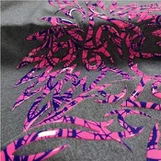Textile screen printing Introduction:
Textile screen printing can use water base ink,plastisol ink,and silicone ink.Because silicone product has much better feature than other ink.Hence,we often recommend our clients to use silicone ink for textle screen printing.
Silicone printing is a modern printing technique that involves using rubber-based ink to create designs and graphic prints on garments and textiles. It offers high versatility, durability, and resistance to wear and tear, making it an ideal choice for the fashion industry. In this article, we will explore the use of silicone printing for clothing accessories ,textile product,fabric and discuss the common issues that may arise during the process.
Today we discuss the silicone ink screen printing on net fabirc.It's elastic fabric,1.5m width,100m/roll.The design team need print the silicone thickness 0.2mm,glossy finish.
Instructions:
Before beginning the silicone printing process, it is important to prepare the fabric and the equipment-automatic screen printing machine. The fabric should be washed and dried beforehand to remove any impurities or debris on its surface. Make sure the printing equipment, such as the screen and squeegee, are clean and free from any previous ink residue.We recommend you use the spreading cloth machine.

1. Preparing the design:
The first step is to create the design or pattern you want to print on the fabric. This can be done using computer graphics software or manually drawing the design on paper. Then the design needs to be transferred to a screen mesh using a light-sensitive emulsion. Allow time for the emulsion to dry, and then expose it to light, which will harden it, creating the stencil.
2. Mixing ink:
Next, mix the silicone ink with the correct proportions of catalyst for proper curing. Use a spatula to stir the ink thoroughly to ensure it is completely mixed and free from lumps or air bubbles. Use a color chart to help you get the right hue or shade you want for your design.
3. Printing:
Lay the fabric on a printing table or flat surface and then position the screen with the stencil on top of the fabric to ensure the design is in the right position. Pour a small amount of ink on the screen. Then use a squeegee to spread the ink over the stenciled area and create the design. Make sure you apply even pressure throughout the screen and squeegee motion to create a uniform print.

4. Curing:
After every screen printing, the ink needs to be cured to ensure its adherence to the fabric and durability in the wash. Curing time and temperature largely depend on the fabric's thickness, ink color, and ambient temperature. Generally, silicone ink requires high temperature and longer curing time than other types of inks. We recommend the baking temperature at 100-120℃,10 seconds for surface dry before next print.
5. Post-curing:
The post-curing process involves exposing the printed fabric to low temperature, typically around 60-80oC for 2-4 hours. The objective is to remove any unwanted volatile organic compounds from the ink and ensure the ink is fully cured, enhancing its durability.Meanwhile,the post-curing can increase the stick force of silicone on fabric.
Common issues and troubleshooting:
1. Clogged screen mesh: ink buildup or dried ink can cause cloggage in the screen mesh. Clean the mesh with a screen cleaner or degreaser to dissolve the ink residue.You can also use the slow catalyst XG-866B-1 to solve the problem.The catalyst will increase the work life of silicone ink.We recommend you add less catalyst in hot day,such as summer.
2. Bleeding or smearing ink: this occurs when the printing is not controlled, or the squeegee is too soft or too hard. Check that the printing is under constant pressure and that the squeegee has the correct hardness.
3. Incomplete or patchy prints: this could be due to under-cured ink or a low-temperature environment. Increase the curing time or the temperature as needed.
Conclusion:
Silicone printing is a versatile and durable printing method for apparel and accessory designs, but it requires a careful and controlled printing process to avoid common issues and ensure quality. With practice and patience, anyone can master the art of silicone printing and create beautiful and lasting designs on garments.
Hot Tags: textile screen printing, suppliers, factory, custom, wholesale, buy, bulk, low price, in stock, free sample, made in China, high density silicone ink, Ink For Fabric, low price Glossy Silicone, Mixture Of Silicone Ink And Colors Made in China, Flocking Silicone suppliers, Screen Printing Material Free Sample












